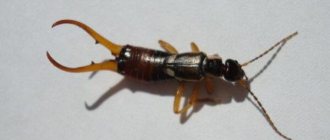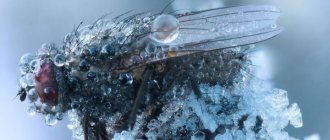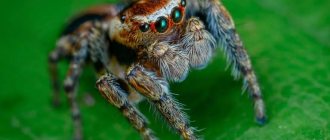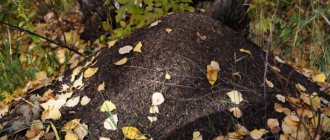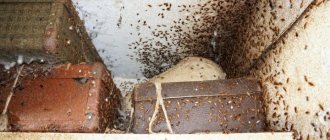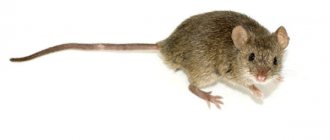A randomly found spider in an apartment is not a reason to panic. It is worth resorting to chemicals and the services of cleaning companies only if a large number of individuals are found in the house.
Before dealing with the problem, it is necessary to determine the cause of the active spread and reproduction of insects.
There are several ways to combat arthropods: from the use of traditional medicine to the use of modern ultrasonic traps.
How to get rid of spiders
In city apartments, spiders often appear in single numbers. In this case, no special treatment is required, since the “unwanted guest” will soon leave the apartment himself if he does not have enough food.
Let's look at several independent ways to exterminate spiders in an apartment:
- Restriction of access to the apartment. All cracks and cracks in the home through which insects can get from the street into the house are sealed. Additionally, windows and bars are repaired. To prevent problems, seal holes around sockets and pipes, where there is easy access for insects.
- Regular wet cleaning of the premises. It is necessary to promptly remove the cobwebs in which the insect makes a nest. Arthropods often make nests on the back surface of sofas or under beds. It is better to burn the found white cocoons of the web.
- Get rid of insects that spiders feed on. Arthropods belong to the category of predators: they feed on mosquitoes, flies and cockroaches. You can eliminate the problem of spiders by destroying other “living creatures” in the house. Arthropods will independently leave the room after their food source disappears.
- Use chemicals and ultrasonic repellers to combat uninvited guests.
- Get rid of all plants in the apartment for a while. Arthropods love to build nests and hide under the leaves of plants.
What species can be found at the dacha
Spiders are predators, representatives of the animal world.
In summer cottages they are found everywhere: both in residential buildings and in nature. The table contains information about spiders that prefer close proximity to humans:
| View | Description |
| Black or gray house spider | A ubiquitous species. Lives in trees and almost does not reproduce at home. Often found in rooms where it enters through open windows and vents. The size of the female reaches 3 cm, the male – 1.5 cm. |
| Harvester, long-legged or moss-legged | Lives in the garden (often on the external walls of houses), but with the onset of cold weather it moves indoors. It has a brown oval body up to 1 cm long and long legs. Prefers to live next to windows, feeding on midges and flies. |
| Hobo Spider | Lives on the street, but is also found in houses, getting there through open doors and windows. It has a brown color and dark stripes on long powerful limbs. The bite of such a spider causes pain and an allergic reaction. |
In the garden there are all the species listed earlier, as well as other arthropods: wasp spider, wolf spider, etc. Almost all of them are harmless to humans, but they can bite if they feel threatened.
Spider bites are most dangerous for children and people with weakened immune systems.
Chemicals
Manufacturers of insect repellent chemicals have developed many types of spider repellents (in the form of aerosols, tablets, crayons and repellents). Their main advantage is ease of use and high effectiveness in combating the problem.
Raid
The manufacturer has been producing products to combat different types of insects for several decades: ants, cockroaches, spiders.
are offered to customers to eliminate spiders . The manufacturer guarantees that after using the product, arthropods will not appear in the apartment for at least 6 months.
Aerosol Raptor against crawling insects
The products are manufactured by a Russian company. Aerosol Raptor is actively used to combat all types of spiders and other types of insects.
Thanks to this, not only arthropods are eliminated, but also the reason for their appearance (sufficient food). The product protects the house from unwanted guests for 2-4 months.
Aerosol against spiders Bros
The product is a disinfectant for premises. The effect of using the aerosol is observed for 3 months. It affects not only adults, but also their eggs.
Chalk “Brownie” or “Mashenka”
With the help of crayons you can fight ants, cockroaches, bedbugs and spiders. Using the product is simple: just draw lines with crayons in places where cobwebs are visible.
Dust Clean House
A bag of chemical is intended for treating your home against insects. 50 g sachet is enough to treat a room of 10 sq.m. If the room in which you are fighting spiders is larger in area, then it is worth purchasing several bags of the drug.
The product is in high demand among buyers due to its effectiveness and low cost. It is better to combine Clean House Dust with other chemicals to permanently get rid of unwanted guests in the house.
Attention! Before using any chemical, you must read the instructions for use and precautions for use.
Do not use an expired product to treat your home, as it will not give results in solving the problem.
Preventive measures
As a rule, such events do not require any special expenditure of time or money, but they have a noticeable effect if everything is done on an ongoing basis, not forgetting that breaks in events are necessarily used by insects to “populate” an apartment or house. This is especially important for those who do not want to put up with an unpleasant neighborhood.
Therefore, the first thing to do is to take care of the cleanliness and order of your home. A mess always attracts various kinds of insects and not just spiders. And here you should always remember not that spiders may appear in the apartment, but that food for spiders does not appear in the apartment. If it is not there, then one spider may settle in the home, which will make sure that some pest does not appear here. If 1-2 spiders settle in an apartment, then, as a rule, they are invisible to the owners, since they do not annoy the residents, like other pests that do not mind profiting from leftover food, and maybe even food supplies.
Treatment
If the cause of the appearance of arthropods is found, then it will not be difficult to cope with their presence in the apartment. Otherwise, you will have to resort to more radical methods: chemical insect repellents, special traps or the services of clearing companies.
In the fight against spiders, specialists use powerful insecticides that will rid the apartment of unwanted guests for a long time.
Before you get rid of spiders in your apartment with the help of specialists, you must:
- remove all food from open areas;
- remove children and pets from the house for a while;
- move all furniture away from the walls to provide specialists with free access to hard-to-reach corners of the apartment.
At the end of the treatment, it is recommended to ventilate the room and do a wet cleaning of the apartment.
Important! It is necessary to clarify information about the disinfection preparations used from premises treatment specialists.
Many of the insect repellents are toxic and after spraying, you will not be allowed to enter the apartment for 2-3 days.
Killing a spider is a good omen
There are countries in the world where people believe that if you kill a spider, this action can attract good fortune. However, everyone warns: you should not try to hurt or kill a living creature in order to attract good luck or wealth - this will not bring anything good.
According to some beliefs, anyone who accidentally kills a spider is freed from forty sins.
If you stumble upon a dead spider or accidentally squash one, it’s okay. A bad omen only applies to those who kill spiders on purpose.
Where and why do they appear?
Let's take a closer look at where spiders appear in apartments. Usually arachnids live outdoors and from there they can enter a person’s home in single quantities.
Insects settle in large numbers in houses and apartments when there is sufficient food for them. The favorite delicacy of arthropods is other small insects.
Let's look at other reasons why many spiders appear in an apartment:
- rare cleaning of premises;
- accumulation of large amounts of dust in secluded corners of the home;
- lack of natural light in the room;
- poor sealing of gaps between doors, windows and staircases;
- missing or damaged mosquito nets on windows;
- windows not closed at night;
- the presence of old woolen items in closets.
With torn mosquito nets and open windows, not only spiders, but also their food source - butterflies, mosquitoes, midges - easily penetrate into a private house.
In order to eliminate spiders, you must first examine the nooks and crannies of the room:
- areas under the bathroom;
- mezzanine;
- storerooms;
- areas behind baseboards;
- areas under the refrigerator;
- wardrobes with fur or clothes.
Stopping spiders from entering your home again
General cleaning has been carried out, available chemicals against furry settlers have been used, all corners have been cleaned, but the question remains of how to prevent the reappearance of unwanted neighbors. Experts recommend thoroughly examining the area of the premises and tightly sealing all the cracks and crevices of wooden surfaces. Securely seal the outlets of communication parts (pipes, joints, drains). Check the safety of the mesh fabric around ventilation grilles and mosquito nets.
Traditional methods
The best folk recipes for spiders are those that include odorous ingredients, because arthropods cannot tolerate strong odors.
Let's look at the most effective folk remedies for getting rid of spiders:
- Peppermint oil solution: 15-20 drops of the product are dissolved in 1 liter of water. The mixture is sprayed around the room using a spray bottle. Skirting boards, corners in the house, cracks on the walls, and places under the window sills are subjected to careful processing. Instead of mint oil, you can use eucalyptus and fir oil.
- Vinegar water. 100 ml of table vinegar (95) is combined with the same amount of water. The solution is used to treat secluded corners of the apartment in the same way as in point 1. Spiders will die after contact with acetic acid. To prevent the problem, you can place bottle caps in the corners of the apartment with a solution of acetic acid poured into them. This technique should not be used in homes where there are small children, as they may accidentally drink the solution and damage the mucous membranes of the digestive system.
- Lemon cut into slices. The strong smell of the product will cause spiders to change their place of residence. You can use hazelnuts instead of citrus fruits. They need to be placed in secluded places in the room.
Video
NO MORE SPIDERS IN THE HOUSE!! This trick is too easy not to know.
Is it possible to kill spiders
Arthropods create their homes, one might say, with the skill of a builder and architect. They successfully choose a place where it is warm and cozy. Not everyone can calmly look at the new tenants - they take a broom or slipper and try to get rid of the tenants. Our grandparents respected the presence of spiders in the house. They were credited with many beneficial properties.
- Experts and sages. It was believed that these arthropods have wisdom, that they store the knowledge of many generations. Therefore, if eight-legged animals settled in a house, then its owners will become wiser and learn what is not given to others. It’s hard to believe, but spiders were even stolen from those who were considered successful and wealthy. Spiders were kept as favorite pets - they were protected from unnecessary labor by bringing fat flies for food.
- Family doctors. It was believed that arthropods are home healers. If a spider crawls along your hand, then you should not be afraid of it, but rejoice. It can protect against illness and give strength to those who are struggling with physical illness.
- Keepers of family happiness. Our ancestors associated the web with the place where happiness is stored. If there is no cobweb, there is no way to maintain family well-being, and the spider helps with this by constantly weaving “lace.” While cleaning, housewives carefully walked around the places of residence of the eight-legged animals, afraid to touch them with a broom and release the family’s well-being from there. Spiders settle in dark corners, which were considered a gathering place for evil spirits, and arthropods expelled them from there, freeing up space for themselves.
- Harbingers of news and surprises. The owners were happy to see a new inhabitant in their house. His appearance was associated with the receipt of good news and the onset of events that would be unexpected, but very pleasant. Yellow and red owners of eight legs bring wealth. Moreover, they bring benefits, even if they are found in a dried state. Colored spiders can serve as a talisman. You will always have money if you put a dried specimen in your wallet. But the death of an arthropod must be natural. If you kill him yourself, you will lose your gifts and wealth.
- Protectors from damage and evil spirits. In past centuries, it was believed that the brownie got spiders, like a pet dog. Killing an eight-legged creature means incurring the wrath of the keeper of the house.
- Money talismans. Our ancestors prescribed ancient knowledge to spiders, communication with otherworldly forces, and tried to conduct rituals with the participation of insects. Red, black and golden individuals were especially revered, as they could help find treasure or receive an unexpected inheritance.
- Home weather forecasters. If rainy weather is expected, the spider will hide. And on the eve of a sunny day, he is busy with his usual work - arranging his home.
- Wish granters. Hardworking by nature, arthropods spend a lot of time weaving webs. If you see them at this moment, you can make a secret wish and wait for what the owner of the lace made with his own paws will “say” about this: if it crawls up, rejoice, the wish will come true, if down, unfortunately, not.
Types of spiders that live in human homes
Harvesting spider
This is one of the most common “taken to life”. Its distinctive feature is its long legs up to 50 mm. Oval or round body, 2-10 mm in length, most often brownish in color. This species is popularly called the centipede. People are used to being around him and are almost not afraid.
Centipedes do not weave the usual cocoon for eggs, but tie them with several threads according to the principle of a string bag. After each eaten victim, they complete the web, so it does not have a clear structure and looks chaotic.
The visual organs of these arthropods are located in 3 on both sides of the head. Another pair of small eyes is in the middle. The height of the abdomen of the harvest spider when viewed from the side exceeds the size of the body.
Gray or black spiders weave a small structured web on which they wait for prey, almost without leaving their nest. They hunt small insects that get into the room.
The lifespan of these species is about 2 years. They rarely reproduce at home, leaving offspring only at the end of the life cycle.
Hobo Spider
This species received its name due to the lack of a permanent habitat. He does not build a web, being in constant motion. The tramp is brown in color with black and beige speckles. Its body is no more than 10 mm long, and its legs are 25 mm.
This species of arthropod hunts on the move, quickly attacking its prey while jumping. It injects the poison immediately and eats the prey on the spot. The hobo spider does not stay in the apartment.
White spider
The body of a female spider of this species can reach 15 mm. Males are much smaller. The common white spider is a frequent visitor to residential areas. He has a large web that gives away his presence.
Jumping spider
The jumping spider is the only herbivorous spider known to science. He rarely lives indoors. This creature is most often carried into an apartment on clothing.
Almost any species of arthropod living in a given region can enter human habitation.
"My brother will avenge me"
This is a strange proposition that has become very common after a string of horror films that featured spiders. According to the plot, relatives from the spider clan came to the one who dared to kill the spider and took merciless revenge. Of course, this is just fiction and the fantastic background of the films. In fact, spiders have no concept of family or kinship relationships. In their system, the weakest male is eaten by the female. This way she receives nutrients and energy for further reproduction of offspring.
Spiders can replace each other. For example, a spider appeared in the house. Remember, you can't kill him. It is absolutely harmless. Spiders are looking for food for themselves, and if there are a lot of different insects in the house, then they will happily settle nearby. For him, this is a marked territory where he gets his food. If a person nevertheless kills this spider, then another will take its place. And of course, not to take revenge - he simply came to the territory with prey. And this prey is definitely not human.
Found a violation? Report content
Types of spiders that live in human homes
As mentioned earlier, there are approximately 40 thousand species of spiders in nature. But no more than a dozen seek to settle at home:
Harvesting spider
This is one of the most common “taken to life”. Its distinctive feature is its long legs up to 50 mm. Oval or round body, 2-10 mm in length, most often brownish in color. This species is popularly called the centipede. People are used to being around him and are almost not afraid.
Centipedes do not weave the usual cocoon for eggs, but tie them with several threads according to the principle of a string bag. After each eaten victim, they complete the web, so it does not have a clear structure and looks chaotic.
The visual organs of these arthropods are located in 3 on both sides of the head. Another pair of small eyes is in the middle. The height of the abdomen of the harvest spider when viewed from the side exceeds the size of the body.
Gray and black spiders
Their body color is monochromatic: black or gray. In this regard, arthropods received appropriate names. They love dry, warm places, so they tend to come indoors with the arrival of autumn. The size of the male of these creatures does not exceed 15 mm in length. At the same time, the female can be 2 times larger.
Gray or black spiders weave a small structured web on which they wait for prey, almost without leaving their nest. They hunt small insects that get into the room.
The lifespan of these species is about 2 years. They rarely reproduce at home, leaving offspring only at the end of the life cycle.
Hobo Spider
This species received its name due to the lack of a permanent habitat. He does not build a web, being in constant motion. The tramp is brown in color with black and beige speckles. Its body is no more than 10 mm long, and its legs are 25 mm.
This species of arthropod hunts on the move, quickly attacking its prey while jumping. It injects the poison immediately and eats the prey on the spot. The hobo spider does not stay in the apartment.
White spider
The body of a female spider of this species can reach 15 mm. Males are much smaller. The common white spider is a frequent visitor to residential areas. He has a large web that gives away his presence.
Jumping spider
It has a specific structure of its limbs, thanks to which it jumps and moves even on a vertical slippery surface, like on a window. Small claws and hairs on its legs allow it to cling. His 8 eyes are located in a special way - in 3 rows.
The jumping spider is the only herbivorous spider known to science. He rarely lives indoors. This creature is most often carried into an apartment on clothing.
Almost any species of arthropod living in a given region can enter human habitation.
What to do if spiders appear?
First, stop panicking, it won’t help you in any way. Next, you need to determine which spider is in front of you - poisonous or not. Most of these insects are harmless, but there are species that pose a danger to humans. You can determine whether a spider is dangerous or not by carefully examining its color and appearance. There are two types of the most famous poisonous spiders. The first species is black in color, without body hair, it has a large belly with a reddish spot resembling an hourglass shape, these spiders are called black widow. The second species, which is brown in color and has a pattern that looks like a violin, is the brown recluse spider.


